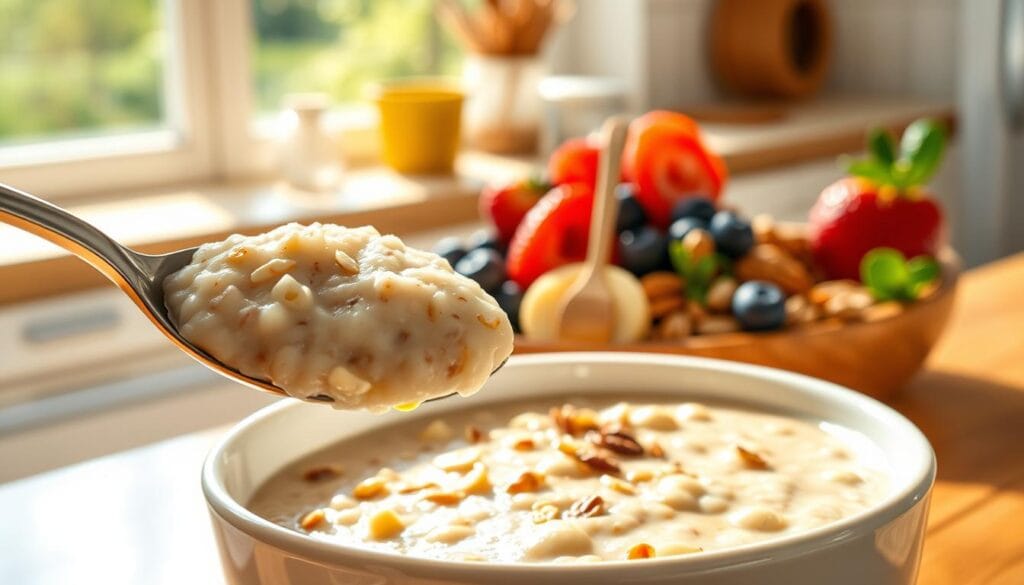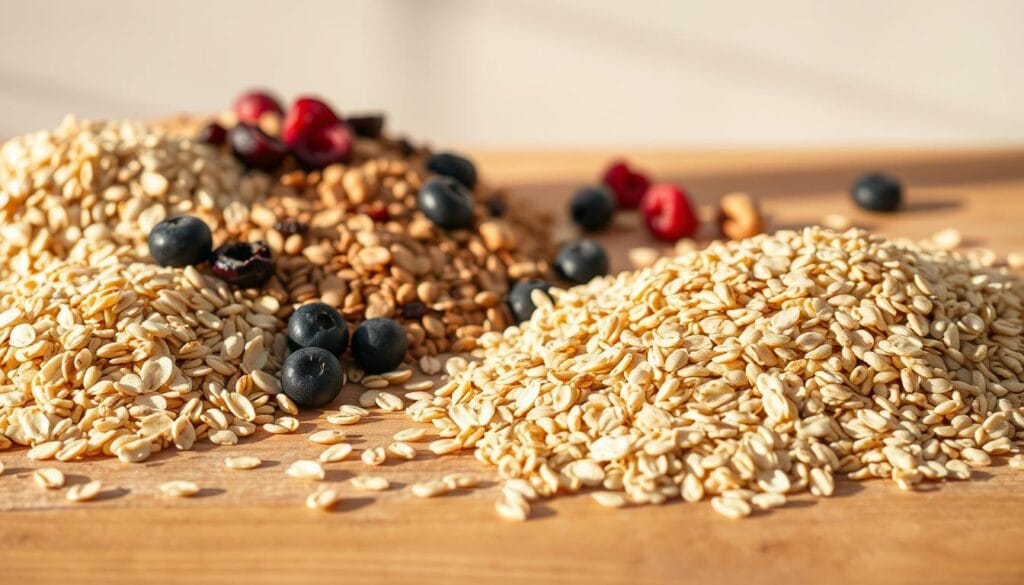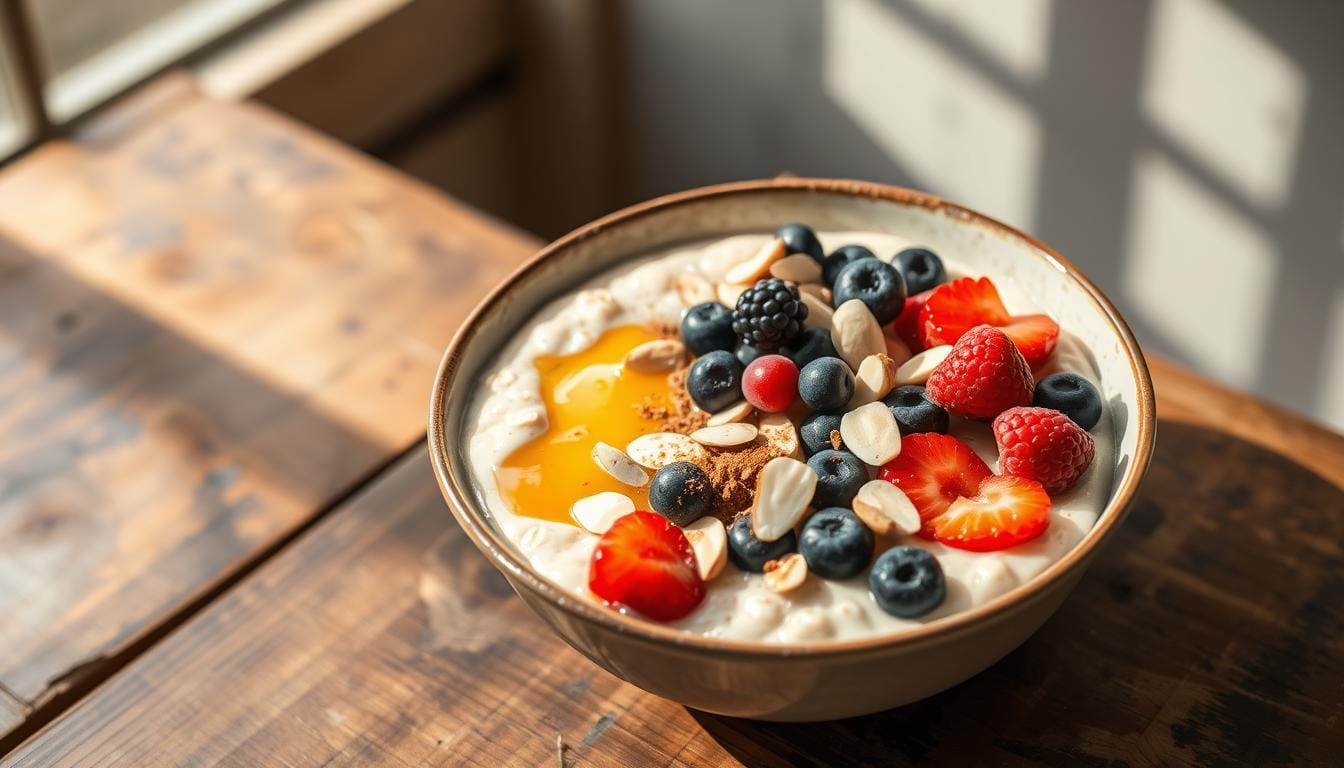Ever thought a simple bowl of oats could be a tasty breakfast? Many see porridge as dull, but it can be exciting. With just 1/3 cup of oats and 2/3 cup of liquid, you can make a dish full of flavors and textures.
Think of adding a ripe banana, cinnamon, and healthy toppings like milled flaxseed or nuts. This oatmeal is packed with fiber, vitamins, and minerals. It’s a great start to your day, keeping you full and satisfied. Ready to try new ways to make your porridge better? Let’s get started!
Table of Contents
Understanding the Benefits of a Healthy Porridge Bowl
Porridge is a nutritious way to start your day. It’s packed with antioxidants and dietary fiber. These are key for keeping you healthy. Knowing the nutritional value of oats helps you make a porridge bowl that meets your needs.
Nutritional Value of Oats
Oats are full of soluble fiber called beta-glucan. Eating 3g of beta-glucan daily can lower blood cholesterol. A 40g serving of oats gives you about 2g of this fiber.
A bowl of porridge made with whole cow’s milk is very nutritious. It includes:
| Nutrient | Amount |
|---|---|
| Calories | 168 Kcal |
| Protein | 7.3g |
| Fat | 7.0g |
| Carbohydrates | 19.9g |
| Fiber | 1.4g |
| Calcium | 196mg |
| Zinc | 1.2mg |
Eating oats can also improve insulin sensitivity and lower blood sugar. Oats are good for your gut health because they have prebiotic fibers.
Importance of Whole Grains
Whole grains, like oats, are very beneficial. They help you feel full and give you lasting energy. Eating whole grains can lower the risk of type II diabetes, heart disease, and some cancers.
A portion of whole oats keeps you full longer and reduces cravings. Nutritionists say to aim for 30g of fiber a day for good gut health.
Health Benefits of Toppings
The toppings you add can make your porridge even healthier. They bring in extra vitamins and minerals. Try adding:
- Fresh fruits for vitamins and natural sweetness
- Nuts for healthy fats and protein
- Seeds for added crunch and nutrients
These toppings not only taste great but also make your meals more interesting and nutritious. By mixing up your toppings, you can make your porridge more flavorful and nutritious, helping you reach your health goals.

Choosing the Right Base for Your Porridge
Choosing the right base is key to a tasty and healthy Healthy Porridge Bowl. Whole oats are popular for their fiber and health benefits. But, there are many grains to try, each with its own taste and texture.
Types of Grains to Use
Oats are great for their antioxidants and heart health benefits. But, you can also try quinoa, rice, and millet for something different. Here’s a quick look at some favorites:
| Grain Type | Benefits | Cooking Time |
|---|---|---|
| Oats (Rolled / Steel-Cut) | High in fiber, low glycemic index | 5-7 mins (rolled), 20-30 mins (steel-cut) |
| Quinoa | Complete protein, rich in magnesium | 15 mins |
| Rice (Brown/White) | Versatile, easy to digest | 30-40 mins |
| Millet | High in iron, gluten-free | 20-25 mins |
Gluten-Free Options
For gluten-free porridge, quinoa and millet are great choices. You can also use gluten-free oats. These options make breakfast delicious and safe for those with dietary needs.
Cooking Methods
Knowing how to cook porridge can make your breakfast better. Stovetop cooking lets grains soak up flavors and get creamy. Or, use the microwave for a quick start:
- Stovetop: Mix water and oats in a pot, cook for 5-7 minutes, stirring occasionally.
- Microwave: Mix oats and water in a bowl, microwave for 90 seconds, stirring in 15-second increments as needed.
- Overnight Oats: Combine oats with liquid and toppings, refrigerate overnight for a ready-to-eat meal in the morning.

Trying different grains, gluten-free options, and cooking methods can lead to endless porridge recipes. Your creativity in choosing the right base will make your breakfast better.
Enhancing Flavor with Natural Sweeteners
Adding sweeteners to your porridge can make it a joy to eat. Natural sweeteners not only add flavor but also bring important nutrients. You might wonder whether to choose honey or maple syrup, or even use fruits as sweeteners.
Honey vs. Maple Syrup
Honey has a rich taste and is packed with antioxidants, vitamins, and minerals. It’s good for blood sugar levels because of its low glycemic index. Honey has about 64 calories per tablespoon and may help with gut health and weight.
Maple syrup also has its benefits. It’s less sweet than sugar but tastes great and has antioxidants. When deciding between honey and maple syrup, remember their different health benefits for your porridge.
Stevia and Other Alternatives
Stevia and other sugar substitutes are low in calories. They can sweeten your porridge without adding many calories. But, use them in small amounts to get the flavor right.
Fruits as Natural Sweeteners
Using fruits as sweeteners makes your porridge sweet and healthy. Bananas, for example, add fiber, potassium, and vitamins. Use 2 tablespoons of mashed bananas for every tablespoon of sugar.
Unsweetened applesauce boosts fiber and antioxidants. Berries add sweetness and help control blood sugar. They make your breakfast both sweet and nutritious.
| Sweetener | Calories (per tablespoon) | Health Benefits | Substitution in Recipes |
|---|---|---|---|
| Honey | 64 | Antioxidants, lower glycemic index, supports gut health | Use as a direct 1:1 replacement for sugar |
| Maple Syrup | 52 | Antioxidants, lower sweetness than sugar | Can substitute equal amounts for sugar |
| Stevia | 0 | Low-calorie, no sugar | Use to taste, very strong sweetening power |
| Mashed Banana | 14 | Fiber, potassium, vitamins B6 and C | 2 tablespoons for every 1 tablespoon of sugar |
| Unsweetened Applesauce | 15 | High in fiber and vitamins | 1:1 ratio for sugar replacement |
Adding Protein for Sustained Energy
Adding enough protein to your porridge makes it more nutritious and keeps you energized all morning. You can choose from dairy like whole milk or Greek yogurt, or go for plant-based options like almond milk or pea protein. Each option brings its own benefits, making your breakfast balanced and fulfilling.
Dairy vs. Plant-Based Options
Dairy products like milk and yogurt make your porridge creamy and are packed with protein. A cup of Greek yogurt adds 6 to 14 grams of protein. Plant-based options, on the other hand, have less saturated fat and more fiber and nutrients.
For example, a scoop of plant-based protein powder has about 24 grams of protein. This makes it a great choice for those who follow a vegan diet.
Nuts and Seeds for Extra Crunch
Adding nuts and seeds to your porridge not only makes it crunchier but also increases its protein. Two tablespoons of nut butter add about 7 grams of protein, making your breakfast more filling. Seeds like chia or hemp are also great, adding healthy fats and extra protein to your meal.
Protein Powders Versus Whole Foods
Protein powders are an easy way to boost your porridge’s protein. A scoop can add 20 grams or more of protein to your bowl. If you prefer whole foods, adding nut butter or using protein-rich ingredients like eggs works well too.
Mixing oats with high-protein foods can create breakfast bowls with 30 grams or more of protein. This ensures you start your day feeling energized and full.
Boosting Your Bowl with Superfoods
Adding superfoods to your porridge bowl makes it taste better and healthier. These foods boost your meal’s nutrition and health. Try adding chia seeds, berries, and spices for a tasty and healthy bowl.
Chia Seeds and Their Benefits
Chia seeds are full of health benefits, with lots of omega-3s and fiber. They help your digestion and heart health. Adding chia seeds to your porridge makes it even more nutritious.
The Role of Berries in Nutrition
Blueberries and strawberries add antioxidants to your porridge. These berries fight oxidative stress and may prevent chronic diseases. They make your bowl sweet and healthier.
Spices to Consider
Spices like cinnamon and nutmeg add flavor and health perks. Cinnamon helps control blood sugar, making it great for your porridge. These spices make your meal delicious and healthy.
Customizing for Dietary Preferences
Creating a healthy porridge bowl can meet many dietary needs. You can make vegan porridge by skipping dairy and using plant-based milk. For low-carb options, try using nutritious grains instead of traditional ones. Allergen-friendly porridge is great for those with specific dietary needs.
Vegan and Vegetarian Options
To make vegan porridge, use plant-based milk like almond or oat milk. Add nut butter, seeds, and fruits for flavor and nutrition. Chia seeds and flaxseeds add healthy fats and fiber without changing the taste or texture.
Low-Carb Variants
For low-carb breakfasts, replace oats with quinoa or cauliflower rice. These alternatives offer unique flavors and textures. Sweeten your porridge with berries or cinnamon instead of sugar to keep carbs low.
Allergen-Friendly Suggestions
For allergen-friendly porridge, choose gluten-free oats and simple toppings. Fruits like bananas, mangoes, or blueberries are sweet without allergens. Plant-based milk makes it creamy and safe for most people.
Preparing Your Healthy Porridge Bowl
Making a healthy porridge bowl is easy and quick. Start by cooking oats in water or milk until they’re creamy. For busy mornings, prep your breakfast ahead of time. Storing porridge properly keeps it fresh for later.
Basic Cooking Instructions
For rolled oats, use 1/2 cup oats to 1 cup of liquid. Boil the liquid, then simmer for 3-4 minutes. For creamier oats, use 1/2 cup oats with 1 1/4 cups of liquid. Quick-cook oats cook in just 2-3 minutes.
Try overnight oats for a quick morning. Let them soak, then cook them in a few minutes.
Meal Prep Tips for Busy Mornings
Make a big batch of oatmeal to save time. Cooked oatmeal stays good in the fridge for 5 days. You can also freeze it for up to 3 months.
Reheat frozen oatmeal for a quick, healthy breakfast.
Best Containers for Storage
Using the right containers is key to keeping oatmeal fresh. Airtight containers are best for the fridge. For freezing, use containers or bags safe for the freezer.
Creative Topping Ideas
Toppings can totally change your healthy porridge bowl. By adding different ingredients, you can make tasty variations. These can meet various tastes and nutritional needs. Here are some exciting topping ideas for porridge to boost flavor, texture, and nutrition.
Fruits and Nuts Combinations
Adding fruits and nuts gives your porridge flavor and crunch. Fresh berries like strawberries, blueberries, and raspberries add flavor and fiber. Nuts like sliced almonds or walnuts bring healthy fats and protein. Here are some favorite fruits and nuts combinations:
- Banana slices with almond butter
- Chopped apples with walnuts and cinnamon
- Mixed berries with hazelnuts and a drizzle of honey
Yogurt and Granola Layers
Adding unsweetened Greek yogurt and granola makes your porridge creamier. It also boosts protein and adds crunch. The mix of textures makes for a great breakfast. You can play with different yogurt and granola flavors.
Seasonal Ingredients
Using seasonal toppings lets you change your recipes with the seasons. In summer, fresh peaches or nectarines brighten your bowl. In fall, warm apple slices or roasted pumpkin add comfort. Seasonal toppings enhance flavor and meet your nutritional goals.
Serving Suggestions and Pairings
When you enjoy your Healthy Porridge Bowl, think about what drinks go well with it. Herbal teas and smoothies are great because they cool down the warm porridge. Try a ginger tea or a berry smoothie for a tasty mix.
Porridge can also be a sweet treat. Add ripe bananas, cocoa powder, or yogurt for a dessert-like bowl. It’s a healthy way to satisfy your sweet tooth without losing flavor.
To please everyone at breakfast, make a big batch of porridge. Add different toppings like toasted pecans or fresh fruits. This way, you can make a meal that everyone loves, with a fancy touch like roasted sweet potatoes or cardamom-spiced granola.
FAQ
What is the healthiest way to eat porridge?
The healthiest way to eat porridge is by using whole grains like oats, and sweetening it naturally with fruit, such as berries or banana slices. To increase nutritional value, add a handful of nuts or seeds for healthy fats and protein. Use water or unsweetened almond milk instead of full-fat milk to keep it lighter.
Is porridge good for a weight loss diet?
Yes, porridge can be a great option for a weight loss diet as it’s high in fiber and keeps you full longer. Oats in porridge are slow-digesting, which can help manage hunger throughout the day. Opt for minimal added sugar and include healthy toppings like fruits, nut butter, or a sprinkle of cinnamon to make it more filling.
Is a bowl of porridge good for you?
Yes, a bowl of porridge is very good for you! It’s a nutrient-rich breakfast option, providing essential fiber, vitamins, and minerals. It can help with digestion, improve heart health, and provide a steady source of energy. The slow-release carbs in porridge make it an excellent choice for a balanced meal.
Is oatmeal and porridge the same thing?
While oatmeal and porridge are often used interchangeably, porridge is a general term for any hot cereal made with grains, while oatmeal specifically refers to a porridge made from oats. So, all oatmeal is porridge, but not all porridge is oatmeal.

